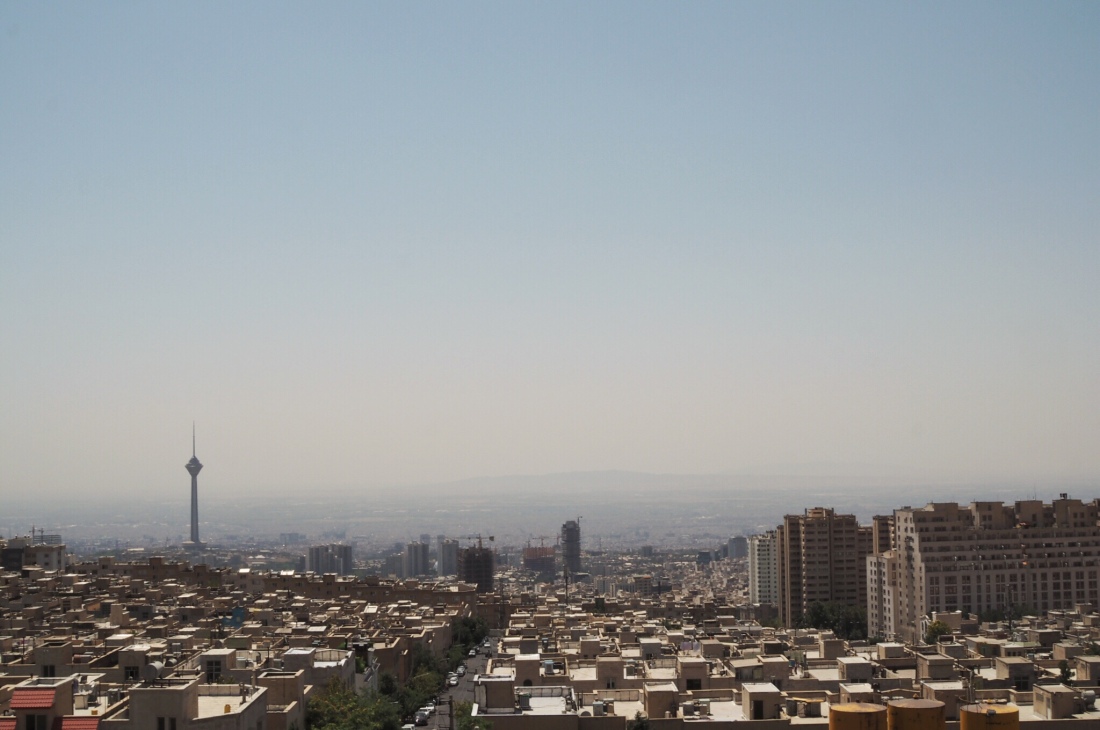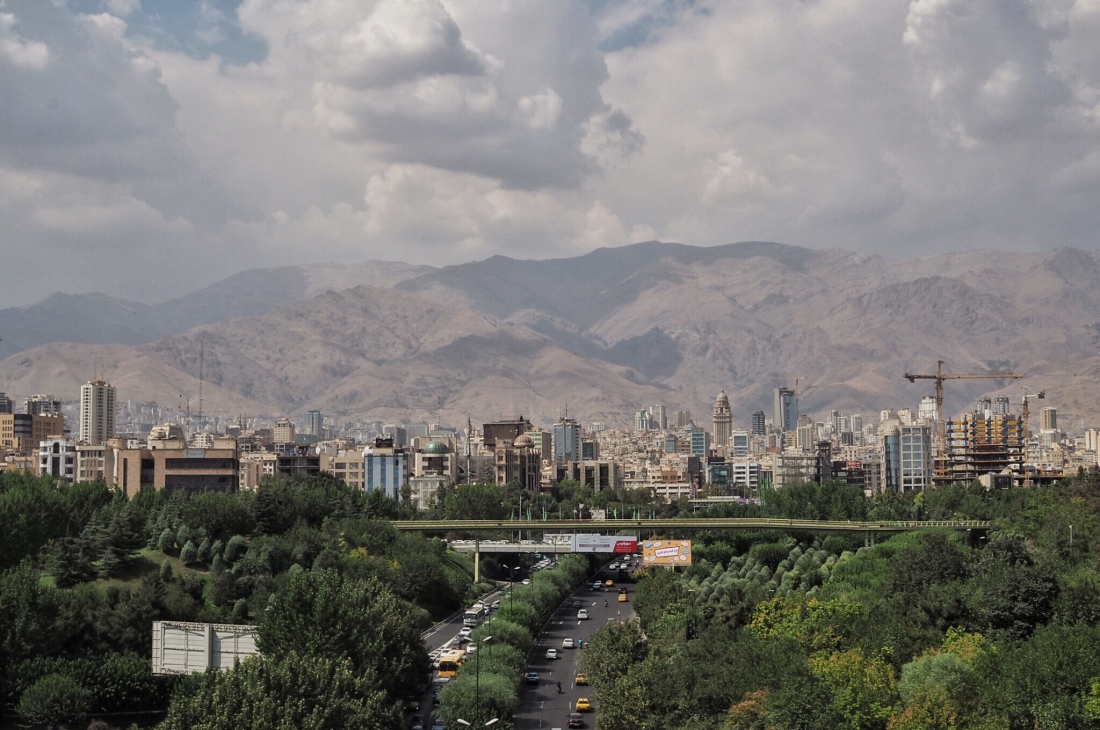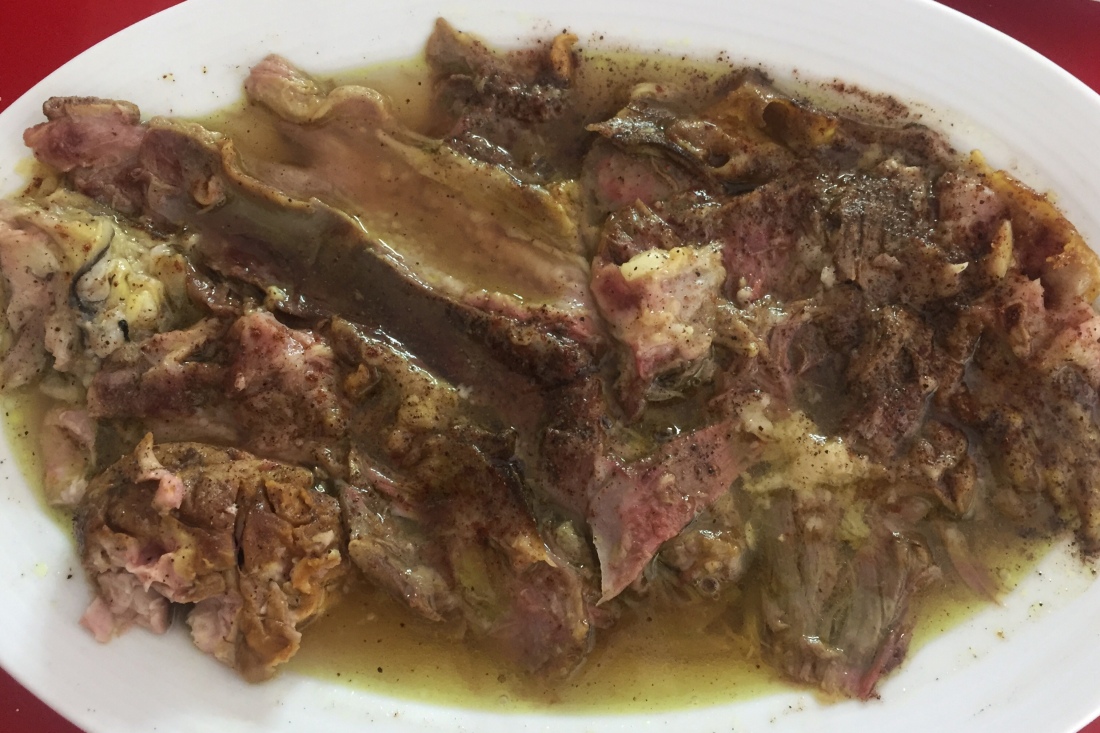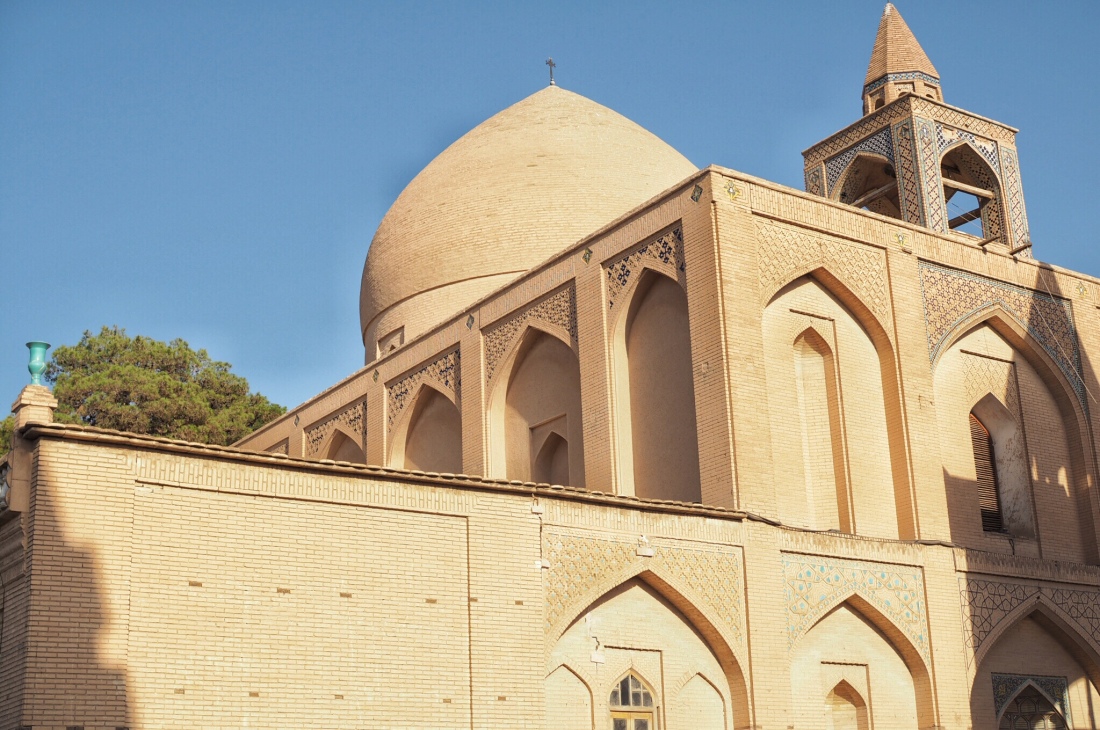Despite some wonderful reports we had entered Iran not knowing what to expect, but our first two weeks there had helped us form our own thoughts on the country and its people. We were delighted by the experience so far, even though the nature of our trip meant we were just getting short glimpses of it all. This was about to change though, as Jordi’s friend and former flatmate, Sam, had arranged for us to stay at his mother’s place in Tehran. We had been messaging with Afsaneh for a few days already and she sounded thrilled to be hosting us. Through her we had been invited to Sam’s cousin’s wedding and she was also taking a couple of days off work to show us around, so things were shaping up nicely and we were looking forward to some much-needed rest days in Tehran.

We reached the outskirts of the city early on a hot afternoon. From the cool and almost empty top of Dizin Pass, at 3.300 m, we had rolled down as both heat and traffic had steadily increased all the way to Tehran. We had an address on the northwestern part of the city, and since we were coming from the north-east we thought we might be able to avoid the city center and reach Afsaneh’s place without much hassle. As soon as we made it out of a narrow valley and saw the city extending into the dusty horizon, however, we realized it wouldn’t be that easy; the immensity of Tehran looked daunting. As it is we managed to avoid the busiest part of the city, but its sheer size and the fact that it is delimited on its northern side by huge mountains meant we spent two long hours on steep highways anyway. We finally reached our destination by sunset, exhausted and dirty from the hills and the fumes.


We settled in at Afsaneh’s place in a matter of minutes, as she turned out to be as nice and talkative in person as she had been on the phone, and it was obvious that she was really happy to have us in her new flat. She provided us with some fresh clothes and an unhealthy amount of food and sweets, all while telling us about herself and life in Tehran. Living alone, she had a very European take on life, which made things very comfortable for us from the very beginning. Up until that point, we had experienced amazing shows of hospitality all over the country from the viewpoint of passing strangers, but our new status as guests brought things to a whole new level. The invitation to the wedding was obviously the most glaring example, but it was far from the only one, and we found ourselves leading something of a social life all of a sudden. We had thought we would have two days to rest before the wedding, but Afsaneh’s friend and neighbor Neda and some of her family took us out for an ice-cream right on our first evening and invited us to a party at her place on the second.


To our amusement Iranian parties, or at least the ones we attended in Tehran, involved a lot of dancing, much more than we are comfortable with. The music was mostly Iranian pop from some top-ten TV channel at top volume, terrible and repetitive to boot. Head-scarves and long coats were left at the door to reveal dresses or skirts, carefully styled hair and lots of make-up among the ladies. There was also delicious home-made food and alcohol ranging from disgusting local beer to passable home-made wine to imported liquors. From talking to a couple of people we suspect parties involving people our age are probably more similar to ours in Europe, but we were very happy to see that other side as well. Needless to say, we adapted quickly and had heaps of fun.

The wedding was a similar kind of party at a very kitschy venue, all glitter and mirrors and pink stuff, with a few funny quirks. We had been looking forward to the food, but we quickly found out that a few hours of wild dancing stood between us and dinner. On the opening dance, we were startled to see an old man approach the dancing couple and gently throw some money (notes, not coins!) over their heads. It was the bride’s father, and it’s a tradition which is supposed to bring luck. It turned out anyone dancing enthusiastically enough gets some money, and by the end of the evening Jordi had earned a few rials himself. We were also very curious about the drinks, as Afsaneh had told us amid laughs that people love to drink at weddings. Here the booze was supplied by the bride’s father in form of a large plastic canister full of vodka hidden under a table in the garden. A few men quickly took seats around the table and, with dinner being withheld until midnight and everyone drinking on empty stomachs, a few of them were very drunk after a couple of hours. All women wore stunning dresses and men were pretty sharp as well. As the only foreigners we gathered a lot of attention; we did our best to mingle and we ended up having a great time.


At the weeding we met Morteza and Mona, a very friendly couple, and we found out they had seen us riding up the Chaloos road a few days before. They invited us to a little get-together at their place the next evening and we accepted after making sure it was no tarof, happy to be making some new friends. The crowd there, mostly Mona’s family and friends, were nice and interesting people, and most of them surprisingly fluent in English. Meanwhile, Morteza’s chicken kabob was the best we tried in Iran by far, and we tried at least two dozen different versions from roadside picnics all over the country. Somebody had brought a big batch of home-made wine, some 40 jars, and we couldn’t help but wonder what would have happened if police had stopped him. One of the guests was Reza, who teaches Spanish among other languages, and after telling him that we were planning a weekend trip to Isfahan he offered to come with us and introduce us to a former Spanish student of his living there.


Our evenings were packed, but during the day we still managed to see some of the city and take care of a few issues. We visited the Golestan Palace, a bazaar and some mosques, and Afsaneh took us to a couple of nice restaurants, of which Kapooieh in the up-market neighborhood of Darvand deserves a special mention. It was the nicest restaurant we had visited in ages and it seemed to be very popular with foreign diplomats. As good as these restaurants were, she figured out that we like the cheap local stuff as well, and she introduced us to jiggah. Jiggah means liver, but it includes all kinds of grilled entrails and fat, all of them delicious, and we went to the same little unassuming jiggah place near her place a couple of times. A friend from Barcelona was in town with friends for a few days and we checked out the impressive Milad Tower together, from where we could see the whole city.




Not all of Tehran was pleasure though, as we had a few things to do before leaving. We left the bikes to a local shop to get them serviced, we took care of the Uzbek visa, and we started proceedings on the dreaded Turkmen visa. Turkmenistan only grants transit visas for 5 days for people on the way to Uzbekistan, and we were reading reports about rejections and an opaque process which gave us no clues on how to approach it best. We filled out our forms, brought them to the embassy and were told to call in ten days. We decided to start heading east while the decision was taken, as we could hardly afford to leave Tehran so late if we wanted to be in Central Asia before winter.


To do all of the above we had to move around the city, which is easier said than done. Tehran is so vast and so dense at the same time that the few metro and bus lines are pretty much useless, and therefore a lot of time is spent in taxis, most of them unofficial. Our foreign looks meant we had to bargain hard to get prices close to the ones Afsaneh would get. Then one day we downloaded an Uber-like app, Snapp, where the price is fixed beforehand, and after that we could enjoy talking to the drivers, the price issue being out of the way. We learnt a lot on those long taxi rides.

Iranians in general, and Tehranis in particular, are aware that their country is being cast in a bad light by some parts of the international community. They are very eager to show that their city is an open place where everyone is welcome, and many vented their frustration at the government as the cause of it all. The people we hung out with during our stay there had the same views as well, and it was obvious, much more than in the countryside, that most of the people tend to a western way of life. On the superficial side, head-scarves are loose and sometimes falling on the streets, in private gardens they are ditched entirely and men wear shorts. In the upper neighborhoods plastic surgery is not only common but prevalent, and beauty salons are absolutely everywhere. We can hardly imagine the bearded guys on the news agreeing with all this. And superficial as they may seem, these are probably just symbols of the more serious issues at stake, like freedom of speech and women’s rights. The readiness shown by Iranians to also discuss more practical problems like the ongoing fall of the currency and the glaring lack of opportunities for educated people, both of which are also blamed on the government, let us suspect that things are going to change, either subtly or dramatically, in the next few years.


Before leaving Tehran, however, we squeezed in a quick 24-hour visit to Isfahan. With Reza, whom we had met at the party, and his musician friend Nadeer we walked around this quiet, beautiful city for an entire day. The contrast to busy Tehran was stunning, and we enjoyed it very much. On Reza’s tip we tried Khale Pache, which means head and leg. Taken from a whole sheep that has been simmering in broth for at least 24 hours, the leg part is pretty much what you imagine while the head part is mainly brain, eye and tongue; it looks less spectacular and tastes much better than it sounds. It is a very popular dish in Iran and it’s served in specialized restaurants, and with the energy it’s supposed to provide we wandered around the old mosques, madrassas and bridges of Isfahan all morning.




Nadeer was an amazing host and an impressive flamenco guitarist, and having studied that instrument for some years in Sevilla he was very knowledgeable about the many similarities between his and the culture in southern Spain, which was eye-opening for us. All in all, Isfahan was a blast, and back in the bus after only 24 hours we felt a bit constrained by our bikes and our way of travel, as we would have loved to explore southern Iran with more time.



Now ready to get back on the road, we said goodbye to Afsaneh after one last glorious home-made meal and went to pick up our bikes. The guys at the shop had done a truly lousy job, and while we quickly turned their excuses into a hefty discount it still left something of a sour taste in our mouths. Getting out of Tehran was tedious and tiring and we made it only as far as Pardis, an ugly commuter town comprising many tall and cheap-looking apartment buildings. Being on the road was supposed to be cooler than breathing exhaust fumes and sleeping in ugly towns, but then our mood lightened for good the next day, as the Haraz Road to the north rewarded a couple of hours of ascent with astounding views on the Damavand and an afternoon-long descent to sea-level.


We were back in the North, and we turned east following the main road to Mashhad. The Caspian Sea was a few kilometers to the north, and the days were rather cloudy now, though still hot. We passed many mid-sized towns, busy and forgettable but for our hosts in a couple of them. Mojtaba, a sailor from Behshahr, was great company and showed us a regional dish called Akbar Joojieh, a whole chicken roasted in butter served with butter sauce and raw onions. It was as tasty as it sounds, although probably not very healthy. Hosts in Gorgan and Minudasht also contributed to make this otherwise unremarkable stretch a lot more interesting.


This last sentence might be a bit unfair to the whole region, but the truth is that we were worrying a lot about the Turkmenistan visa. We were reading reports from people being rejected, and the many hours on the road and among ourselves weren’t helping clear our minds. Finally, just outside Kalaleh, we called the number we had been given ten days earlier. After speaking to a couple of people and being asked to call again ten minutes later, we finally got hold of someone who seemed to be in charge. Mr. Bosch, two brothers from Spain, rejected, he was very sorry. He couldn’t give us a reason, it was in the system, he was just reading from a screen, he was very sorry again, and that was it. This crushed all our plans and, while we had known this could happen, it still left us in shock for a while.


We had been planning to cycle to Khaled Nabi, a shrine at the end of a 60 km cul-de-sac overlooking the Turkmen desert, after a tip from Pol and Kiku, who we had met in Istanbul. We figured out we might as well go and take a look at Turkmenistan anyway, and think about our next steps while cycling there and back. The last climb to the shrine was unpaved and hard and knowing we had to go back exactly that same long stretch the next day felt somehow very, very weird, but Khaled Nabi didn’t disappoint. We arrived in the dark and pitched our tent, and next morning we took in the beautiful views and visited an early Christian cemetery nearby.


We also came up with a plan, taking advantage of a new friend we had made the day before. A local, Dayan, had approached us in Kalaleh right after the rejection, inviting us to rest at his place in surprisingly good English. We would need the whole afternoon to get to Khaled Nabi and Iranian hospitality takes time, so we had declined politely, but somehow he had found us again before we had left town and had brought us a delicious home-made lunch anyway. He had also given us his number just in case we needed anything, and now we did.


The obvious thing to do was head back to Tehran and fly to Uzbekistan, as going back to Azerbaijan to take the ferry across the Caspian would take too long. Those flights were 400$ each, more than what we spend in a whole month on this part of the world. So before going the obvious, super expensive way, we looked at all possible alternatives. We read in a forum that someone had shown up at the Turkmenistan consulate in Mashhad after having been rejected 24 hours earlier and got his visa somehow. Maybe the people in Mashhad couldn’t access the system and the consul was just granting visas to cover the fuck-up, maybe the guys in Tehran were just flipping a coin on the spot and putting the result in the system later. That being Turkmenistan, who knows. In any case, we felt we still had a very small chance if we got to Mashhad in the next one or two days.


It was not much, but looking at those 400$ and the fact that our trip wouldn’t be continuous anymore meant we had to try. So we called Dayan after getting back from Khaled Nabi that afternoon to see if he could take care of our bikes, and of course he could. He also helped us hail a ride to Mashhad and arranged a place to sleep at his cousin’s motel there for us. We were at the Mashhad consulate as they opened the very next morning and after five minutes of extremely polite conversation it was clear that our rejection was in the system, and our last hope was gone. Feeling a bit despondent, we told ourselves that we had done all we could now, and if they weren’t having us they could keep their dusty desert for themselves. As for Mashhad, we were too disappointed to hang around the city, and the few streets we had seen hadn’t dazzled us anyway. We left right away, all the landscapes we wouldn’t be cycling through flying past our ride’s windows for a second day in a row. That afternoon we were back at Dayan’s place, having hitchhiked 1.000 km in less than 24 hours for nothing. No matter how we looked at it, we were truly, deeply disappointed.

This post isn’t going to end on a low though, as many good things started happening from that very moment. We got to spend a whole evening at Dayan’s before taking a night bus back to Tehran. He is one of many Turkmen living in Iran, and we tried typical Turkmen food while he told us about their culture, learning more about the country than we probably would have done rushing through the desert on a five-day visa. In Tehran we saw Afsaneh again, and gained almost a kilo a day during the happy, lazy week we spent at her place. Feeling we deserved some good fortune we decided to take a crack at the always complicated Chinese visa, instead of sorting it out somewhere in Central Asia. The paperwork, fake itinerary included, was a pain in the ass, but the God of Tricky Visas maybe owed us one, because we got our visas approved in five minutes. We had now all the visas we would need for the next six months, if we wanted to stay on the road for that long, and our trip was definitely back on track.


Packing our bikes for the flight was an adventure in itself, but we were on a roll now and the lovely Iranian people came to the rescue one last time. Reza, a friend of a friend of a friend and an avid cyclist himself, showed up at our place one evening with two bike boxes and a set of tools. What a hero he turned out to be, driving around Tehran with Joan’s bike on top of the car looking for a mechanic who would help loosen a stuck pedal. We also got in contact with Aleix, a guy from Barcelona whose bike had been in the same bike shop as ours and whose number we had seen there, scribbled on a notepad. He told us that he had been rejected by Turkmenistan as well, so we got ourselves a new travel buddy. And although the flight to Uzbekistan was indeed expensive, the views over the Caspian Sea and the Turkmen desert at sunrise had us gawking out the windows for hours. The three of us would also get to see beautiful Tashkent now, which most cyclists have to skip as it’s usually a long detour. That, however, is stuff for the next post already.

To close this post a few words on Iran are due. As always, for every place we visited we missed ten others, but this time we think we got the general picture, and we definitely liked most of what we saw. The scorching heat was a novelty which kept us busy, the varied landscapes were gorgeous, the culture and architecture of Iran had a depth and richness that took us by surprise, and the food, from the simplest bread to the most elaborate dishes, was simply awesome. At the same time and due to many factors, the country is obviously going through a complicated time, and as visitors we could feel big changes lie ahead; it was always compelling to learn more about this.
Some laws and traditions appeared deeply wrong or unjust in our eyes, but we also saw that most people push against or work around them in ways that range from incredibly brave to outrageously witty. Those same people are the true magic of Iran, as nowhere else have we encountered such a lovely, generous folk. This is not meant to demean people elsewhere, but the consistency and the quality of Iranian hospitality was just ridiculous. Bought food, for which we sometimes weren’t allowed to pay anyway, would go bad in our panniers because of all sorts of invitations and gifts. The few times we needed advice, passers-by would leave everything at once and try to help us out. As complete strangers we were guests in many homes, and on the receiving end of many small and a couple of not so small favours. We entered Iran with curiosity but also with doubts and worries. We left feeling in debt with this incredible country and in love with its wonderful people.

I like this weblog somuch, saved tomy bookmarks.
LikeLike